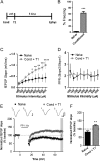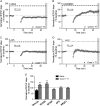Contextual Fear Extinction Induces Hippocampal Metaplasticity Mediated by Metabotropic Glutamate Receptor 5
- PMID: 29136107
- PMCID: PMC6454528
- DOI: 10.1093/cercor/bhx282
Contextual Fear Extinction Induces Hippocampal Metaplasticity Mediated by Metabotropic Glutamate Receptor 5
Abstract
Dysregulated fear memory can lead to a broad spectrum of anxiety disorders. The brain systems underlying fear memory are manifold, with the hippocampus being prominently involved by housing fear-related spatial memories as engrams, which are created and stored through neural changes such as synaptic plasticity. Although metabotropic glutamate (mGlu) receptors contribute significantly to both fear behavior and hippocampal synaptic plasticity, the relationship between these two phenomena has not been fully elucidated. Here, we report that contextual fear extinction induces a novel form of metaplasticity mediated by mGlu5 at the hippocampal SC-CA1 synapse. Further, blockade of mGlu5 prevents both contextual fear extinction and expression of this metaplasticity. This form of metaplasticity was absent in a mouse model of MECP2-duplication syndrome, corresponding to a complete deficit in extinction learning. These findings suggest that mGlu5-dependent metaplasticity within the hippocampus may play a critical role in extinction of contextual fear.
Figures








Similar articles
-
Selective modification of short-term hippocampal synaptic plasticity and impaired memory extinction in mice with a congenitally reduced hippocampal commissure.J Neurosci. 2002 Sep 15;22(18):8277-86. doi: 10.1523/JNEUROSCI.22-18-08277.2002. J Neurosci. 2002. PMID: 12223582 Free PMC article.
-
Aquaporin-4 deficiency facilitates fear memory extinction in the hippocampus through excessive activation of extrasynaptic GluN2B-containing NMDA receptors.Neuropharmacology. 2017 Jan;112(Pt A):124-134. doi: 10.1016/j.neuropharm.2016.06.031. Epub 2016 Jun 29. Neuropharmacology. 2017. PMID: 27373674
-
Synaptic modulation via basolateral amygdala on the rat hippocampus-medial prefrontal cortex pathway in fear extinction.J Pharmacol Sci. 2013;123(3):267-78. doi: 10.1254/jphs.13123fp. Epub 2013 Nov 2. J Pharmacol Sci. 2013. PMID: 24189655
-
The learning of fear extinction.Neurosci Biobehav Rev. 2014 Nov;47:670-83. doi: 10.1016/j.neubiorev.2014.10.016. Neurosci Biobehav Rev. 2014. PMID: 25452113 Review.
-
Hippocampal involvement in contextual modulation of fear extinction.Hippocampus. 2007;17(9):749-58. doi: 10.1002/hipo.20331. Hippocampus. 2007. PMID: 17604353 Review.
Cited by
-
M1 Muscarinic Receptors Modulate Fear-Related Inputs to the Prefrontal Cortex: Implications for Novel Treatments of Posttraumatic Stress Disorder.Biol Psychiatry. 2019 Jun 15;85(12):989-1000. doi: 10.1016/j.biopsych.2019.02.020. Epub 2019 Mar 7. Biol Psychiatry. 2019. PMID: 31003787 Free PMC article.
-
Allosteric Modulators of Metabotropic Glutamate Receptors as Novel Therapeutics for Neuropsychiatric Disease.Pharmacol Rev. 2022 Jul;74(3):630-661. doi: 10.1124/pharmrev.121.000540. Pharmacol Rev. 2022. PMID: 35710132 Free PMC article. Review.
-
A proposed mechanism for the MDMA-mediated extinction of traumatic memories in PTSD patients treated with MDMA-assisted therapy.Front Psychiatry. 2022 Oct 12;13:991753. doi: 10.3389/fpsyt.2022.991753. eCollection 2022. Front Psychiatry. 2022. PMID: 36311515 Free PMC article. Review.
-
Neuropharmacological Insight from Allosteric Modulation of mGlu Receptors.Trends Pharmacol Sci. 2019 Apr;40(4):240-252. doi: 10.1016/j.tips.2019.02.006. Epub 2019 Feb 26. Trends Pharmacol Sci. 2019. PMID: 30824180 Free PMC article. Review.
-
Calcineurin Participation in Hebbian and Homeostatic Plasticity Associated With Extinction.Front Cell Neurosci. 2021 Jun 16;15:685838. doi: 10.3389/fncel.2021.685838. eCollection 2021. Front Cell Neurosci. 2021. PMID: 34220454 Free PMC article. Review.
References
-
- Abel T, Lattal KM. 2001. Molecular mechanisms of memory acquisition, consolidation and retrieval. Curr Opin Neurobiol. 11(2):180–187. - PubMed
-
- Abraham WC. 2008. Metaplasticity: tuning synapses and networks for plasticity. Nat Rev Neurosci. 9(5):387. - PubMed
-
- Abraham WC, Bear MF. 1996. Metaplasticity: the plasticity of synaptic plasticity. Trends Neurosci. 19(4):126–130. - PubMed
Publication types
MeSH terms
Substances
Grants and funding
LinkOut - more resources
Full Text Sources
Other Literature Sources
Molecular Biology Databases
Research Materials
Miscellaneous

